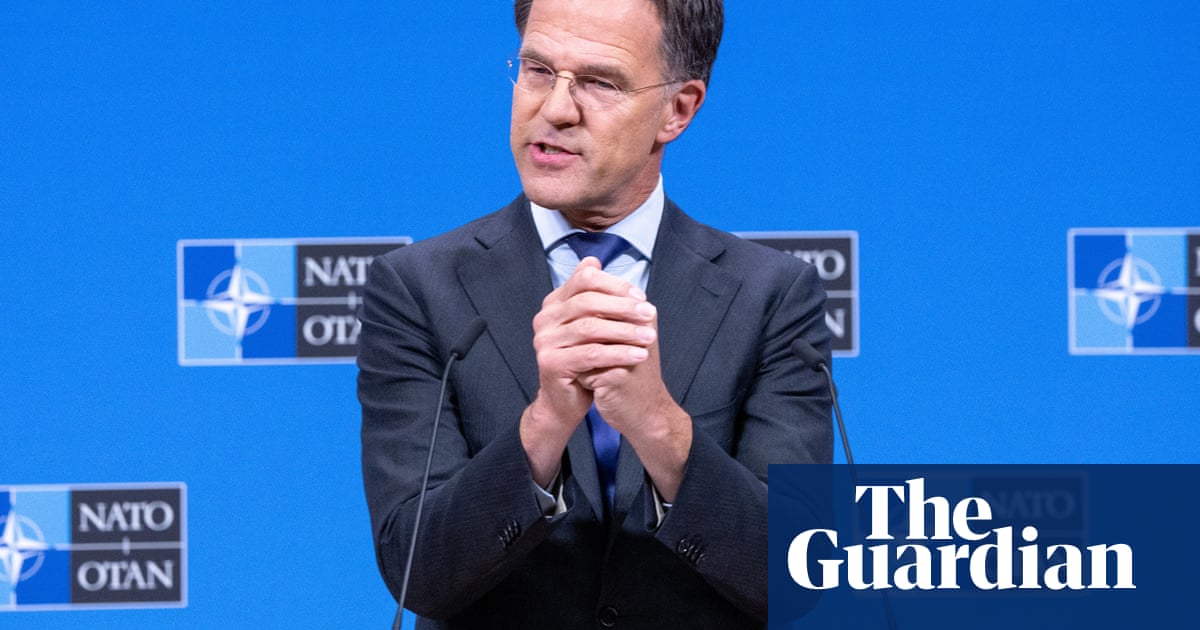Russia will remain an imminent threat to Nato even if there is peace inUkraineand the western alliance has to increase its air and missiles defences by 400% as a result, the head of the organisation will say on Monday.
Mark Rutte, who is visiting the UK and meeting the prime minister, Keir Starmer, is expected to outline why it is necessary for allies to agree a dramatic increase in military spending to 5% of GDP at a summit in The Hague later this month.
At a speech at the Chatham House thinktank in London on Monday afternoon, theNatosecretary general will argue the alliance needs “a quantum leap in our collective defence” and “more forces and capabilities to implement our defence plans in full”.
Critically, Rutte is expected to say “the fact is, danger will not disappear even when the war in Ukraine ends”, reflecting a belief that the Kremlin will not demilitarise even it agrees to a ceasefire and eventually a peace with Kyiv.
Military planners believe thatRussiawill seek to retain an active and experienced army in excess of 600,000-strong and maintain elevated levels of defence spending of about 6.5% of the country’s GDP, so threatening Nato’s eastern flank.
Rutte will first visit Sheffield Forgemasters, a nationalised steelmaker owned by the Ministry of Defence which makes complex components for nuclear submarines, before meeting Starmer and then giving his speech.
The secretary general, a former Dutch prime minister,has been pushing a proposalfor Nato members to agree to lift core defence spending to 3.5% of GDP by about 2035, with a further 1.5% on cyber and other related military infrastructure.
Britain is expected to sign up to the plan, to be formally confirmed at the summit, as part of an effort to maintain the support of the US president, Donald Trump, who pressed for the new 5% target once he was elected president for a second term.
Justifying the need for extra spending, Rutte is expected to say that Nato needs “a 400% increase in air and missile defence” as part of a wider rearmament to maintain credible deterrence and defence.
“We see in Ukraine how Russia delivers terror from above, so we will strengthen the shield that protects our skies,” Rutte is expected to say, according to remarks trailed by Nato ahead of the speech, due to begin at 3.45pm London time (1645 GMT).
There will also have to be wider restocking of weapons, run down initially during the long period of post-old ar peace and second, because so much has been donated to Ukraine to help it fend off the full-scale Russian invasion over the past three years.
“Our militaries also need thousands more armoured vehicles and tanks, millions more artillery shells, and we must double our enabling capabilities, such as logistics, supply, transportation, and medical support,” Rutte will add.
Sign up toFirst Edition
Our morning email breaks down the key stories of the day, telling you what’s happening and why it matters
after newsletter promotion
Britain haspromised to increase defence spendingfrom the current 2.33% of GDP to 2.5% by 2027 and to 3% in the early 2030s. But a week ago, Starmer acknowledged that discussions about Nato’s future military needs were also taking place.
“There are discussions about what the contribution should be going into the Nato conference in two or three weeks’ time,” the prime minister said as he unveiled the UK’s strategic defence review, as part of a wider conversation about “what sort of Nato will be capable of being as effective in the future”.
Rutte is expected to welcome theUK’s strategic defence review, which he will say will “enhance Nato’s collective defence”. The document said Britain faced “a new era of threat” and that in order to deter Russia the UK had to become, in the words of Starmer, “battle-ready”.
Last week, one of the three members of the defence review team, the foreign policy expert Fiona Hill, said the UK needed to recognise that Russia considered itself at war with Britain and that the US under Trump was no longer a reliable ally. “We’re in pretty big trouble,” Hill said in aninterview with the Guardian.
